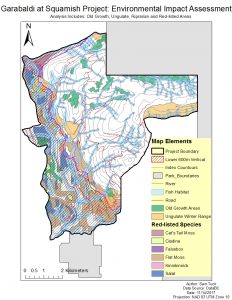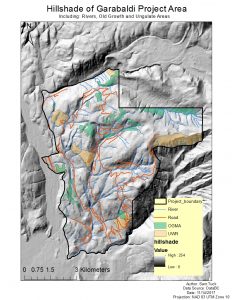The Maps and report included below are taken from Lab 5 of my Geob 270 Class. Out of all the labs, this lab, and the resulting map and report was my favorite to produce, as well as some of my best work from this class. As background, the report is written from the perspective of a natural resource planner working for the project proponents. The report is meant as an environmental impact assessment, in order to advise the proponents on how to continue in the face of environmental concerns. I will first present the map, report and hillshade, followed by a conclusion after the fact. Hope you enjoy.

The Garabaldi at Squamish Project is a ski resort development project located on Brohm Ridge just outside of Squamish. The ski resort includes 124 ski trails and 21 lifts, along with resort accommodation and multiple commercial developments. There are a number of past criticisms of the project’s environmental impacts from the BC Environmental Assessment Office, as well as Whistler Ski Resort. The BC EAO found the original proposal lacking in information as to potential effects on vegetation and wildlife habitat, while Whistler cited climatological considerations which had been overlooked, such as the scientific climate projections which would make skiing unreliable or not possible on the lower 600m of vertical.
As a natural resource planner hired by Garabaldi at Squamish project, I hope to evaluate in this report, previous criticisms of the project as well add my own opinions and assessment to light. I will first explain my analysis of the development and its environmental concerns as well as present the results of this analysis. I will pair this with a discussion what I personally believe to be the most important of the environmental concerns presented, as well as my thoughts on what options the project developers have as to mitigating these environmental concerns.
Analysis:
My analysis and assessment of this project is situated around a map I created in order to visualize the cumulative effect of all environmental concerns which pertain to Garabaldi at Squamish. Each concern will be also be discussed and analyzed on its own, in order to show the relative weight of each of these concerns.
In order to analyze the proposed projects effects on the natural resources and ecosystem services that Brohm Ridge provides, I first obtained data from the BC Government as to relevant environmental concerns in the area. These included: Ungulate Winter Ranges, Old Growth Management Areas, Terrestrial Ecosystems, Rivers and a digital elevation model and landscape contours to highlight climatic change concerns. I then combined all relevant layers and clipped them so that only the environmental concerns which existed within the project boundary were addressed:
The first concern addressed was climatic. I used a digital elevation model to find just how much of the proposed resort would be in danger of un-skiiable conditions, based on climate change models indicating significant loss of snow pack on the lower 600m of vertical by the time this resort would be built and operational. According to my analysis, the lower 600m makes up 31.789% of the total project area.
I then moved to analyze what animals and vegetation would be impacted by the project; specifically, species and habitats which are already endangered, redlisted or protected under environmental law. I found, through comparing the area that these protected habitats and species take up to the total project area, that:
- Old Growth Forests make up 6.78% of the total project area.
- Ungulate Winter Ranges account for 7.89% of the total project area (mule deer = 4.24%, and mountain goat = 3.65%)
- Fish bearing streams and associated riprarian habitats make up 28.43% of the total project area.
- Red-listed species habitats make up 24.83% of the total project area. (Falsebox, Salal, Cladina, Kinniokinnick, Flat Moss and Cat’s Tail Moss)
Response and Suggested Mitigations:
Not including the lower 600m of vertical, the total amount of project area which is taken up by protected areas is 53.7%. As you can see from the map, many of these protected areas overlap, and thus a key element to analyzing environmental impact is the cumulative effect that the project could have on protected flora and fauna, especially in these key areas of overlap. As such it is important to not think of these environmental concerns as existing as mutually exclusive from one another, but as acting interdependently, as all of these elements of concern such as vegetation and animals exist as part of an ecological system where effects on one ripple throughout, to impact the whole system.
That being said, if I had to point to what I believe to be the two greatest environmental concerns to the projects development, I would choose 1. Climatic change models affecting snowfall and 2. Red listed species habitats.
I choose climate change models due to the fact that climate change is a very real process which is very difficult to mitigate in a short period of time. Assuming the models presented are correct, then by the time the project is completed and open to the public, actually having snow for guests to ski on may threaten the viability, and profitability of the initial investment to build the project.
Red-listed species I also believe to be one of the greatest concerns due to the fact that, based on the map, these species exist generally within the lower 600m of vertical. Furthermore, and possibly of greater importance, as vegetation they can be easily disturbed or threatened from not only the massive construction, logging and general resort development, but also the continued use of the area as a ski resort. As they are species which are already significantly threatened, and due to the fact they take up such a large percentage of the project area; I would argue they are of greatest concern to the projects environmental impact.
Conclusion:
While the first concern I have presented really has no way of being mitigated directly through the building of the project, the second concern might be mitigated in a number of ways. First, I would suggest that these areas be identified and marked so that construction surrounding them is minimized or controlled so as not disturb their growth. I would also suggest creating environmentally sensitive boundaries for skiers and resort guests so as to further protect these species from disturbance.

For this Lab I was assigned the role of a natural resource planner who was hired by the people in charge of Garabaldi at Squamish. Thus, while in the report I try and stress the importance of addressing environmental concerns; I inevitably have to side with the project and assume that it will continue as planned. However, personally I do not believe that this project should go through; not only because of the environmental concerns associated with it (which, from my analysis and resultant map seem to be overwhelming) but also, as hinted in my suggestions, simply not economically viable for the project proponents. It seems to me to be absurd to be building a completely new, and incredibly ecologicaly distruptive ski resort at a time when science is overwhelmingly in agreement of the empirical truth of climate change and global warming. Not only will temperature levels continue to rise along with the number of extreme weather events, but these are only estimates based on our current consumuption levels, and are not able to predict the cumulative effects of continued consumption over the number of years it takes to slow down our current rates of growth. Furthermore, earths climate cycles are slow in relation to human cycles of development. It is possible that we are only seeing the tip of the iceberg when it comes to climate change, and that all we do to stop our consumption will still not have and effect on the resultant warming levels. Thus; not only is it irrational to build this resort in the face of this science and the predictions for snowfall on the lowest 600m of vertical, but it is also seems absurd to pair this fact with the large-scale ecological disruption needed to build such an inevitably doomed project. While the project proponents may make their money back, the time frame in which it will take to complete the project, attract visitors and begin making profit is just too long to fit inside the short window climate change has allowed us to continue our current lifestyle. Thus I believe it is not only absurd from the point of view of a resource conservationist or environmental scientist; it is also economically irrational and unviable as an idea.